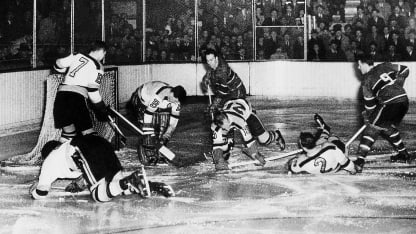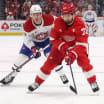Chalk another one up for The Rocket
Maurice Richard is credited with a new assist after the NHL digitized its game sheets going all the way back to 1917-18

To
Maurice "Rocket" Richard
. In 1945-46.
That's because,
as first reported by Bill Beacon
, the NHL recently completed a massive digitization project of its historical statistics, led by chief statistician Benny Ercolani. The project allowed the League to compile game data going back to its very first season, 1917-18, whereas some of it was previously only available starting with the 1987-88 campaign.
The truth is, the aforementioned assist belonged to The Rocket all along.
In early November 1945,
in a game against the Boston Bruins
,
Hector "Toe" Blake
scored his second goal of the night at 10:15 of the second period and was assisted by the famous No. 9. When the scoresheet was being recorded into the League's official register, the handwriting on the page was misinterpreted and the assist was given to one of Richard's teammates instead.
"We had these big ledgers where they would transpose the information from the scoresheets]. When they were transposing it, instead of putting the assist to Richard, they gave it to
[[Emile "Butch"] Bouchard
," explained Ercolani, who joined the League office in 1976. "That's why that discrepancy was there. We found that by going into detail on each goal and assist."
And so, 57 years after the Rocket last skated in NHL action, another assist has been officially added to his career tally, bringing his totals to 544 goals and 422 assists for 966 points.
Richard's new assist is one of but many new additions, subtractions, and corrections that were made to player records as a result of the digitization effort, which is understandable given that the project took six years to complete - just over half of which was spent on data entry alone.
Ercolani and his team conducted their analysis by poring over every single game sheet - yes, the original hard copies, in case you were curious - and entering the data digitally. If ever there was a discrepancy, say, due to difficult handwriting, the researchers would compare their records with newspaper boxscores in order to come to a conclusion. The NHL's head stats man asserts that no stone was left unturned, that there was no data point that could not be definitively determined.
In addition to the Habs Hall-of-Famer's extra assist, there were several other significant changes made to Canadiens player statistics.
Ken Reardon
was credited with playing 12 more games in 1940-41 than had previously been recorded.
Howie Morenz
had three more assists added to his haul from 1929-30.
Serge Savard
(1970-71) and
Guy Lafleur
(1978-79) were each credited with an additional game-winning goal, while
Charlie Hodge
was given three more wins in 1966-67 - at
Lorne "Gump" Worsley
's expense. And the list goes on.
15,000,000 new data points from 59,753 games.
— NHL (@NHL) September 27, 2017
100 years of game-by-game stats now have one home: https://t.co/3mFksIgEOU#NHL100 #NHLStats https://t.co/RbEB2T2a6v
Ercolani relied on an enormous team of people to get the job done, which included getting help from club historians - the Canadiens' Carl Lavigne among them - when his own information was inconclusive. He even had to enlist the services of the NHL's IT department to assist with data that couldn't be entered using existing League parameters.
"There were so many different rule changes over the years. We had one year where they would give three-minute penalties. With the existing system, there's a check and balance where the system would tell you you can't have a three-minute penalty. We had to adjust for all this," recounted Ercolani, who credited his predecessors and past League presidents for preserving the historical data so well. "There were 20-minute overtime periods, three and four assists on a goal, things like that."
Another quirky one took place in 1938. The research team discovered what Ercolani believes to be the first known instance of a player - former Detroit Red Wing Modere "Mud" Bruneteau - taking part in two penalty shots in one game. At the time, the rule had recently changed whereby a penalty to a goalie would automatically result in a penalty shot. In this case, the offending netminder was mistakenly registered as having served in the box instead. The records have now been corrected to credit Bruneteau with the penalty shot.
Other stats, like power play points and save percentages, were not computerized prior to the 1980's and are also now in the system. Player headshots, wherever available, were added to their online cards.
With all the data entry and verification now complete and the information available for use on NHL.com, Ercolani has already started dreaming about what comes next, although that hasn't stopped him from stepping back to soak it all in.
"The whole reason we started this project was the fans. Now] they have the tools, which they can find on NHL.com. That will be fun for them," said Ercolani, who imagines tying in video highlights to old scoresheets online as a potential future project. "The commissioner wanted us to preserve all this information and bring it to life so that the fans could read the boxscores.
"We owe a debt of gratitude to all the people before us. If they hadn't done what they did over the years, we wouldn't have had all this information," he concluded. "It gives me great joy and pride when I go to NHL.com and see all the numbers there now that used to just be dashes."
Stats junkies can head to
[NHL.com/stats
and start searching away.
Related:
- Video: NHL.com Historical Stats Tutorial
- Video: The Evolution of NHL Statistics
- NHL puts historical stats at your fingertips
- Press release: NHL offers online access to 100 years of player, team, game stats


















